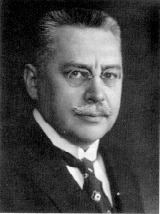Role Economist Name Ladislaus Bortkiewicz | ||
 | ||
Born August 7, 1868Saint Petersburg, Imperial Russia ( 1868-08-07 ) Institutions University of Berlin 1901–31 ProfessorAlexandrowskii Lyceum 1899–00Russian Railways 1897–01University of Strasbourg, 1895–1897 Privatdozent Alma mater University of Strasbourg, Habilitation 1895University of Gottingen, Ph.D. 1893University of Saint Petersburg 1890 Known for Poisson distributionTransformation problem Books Elements of Mathematical Statistics: Also L.v. Bortkiewicz, Table of Poissons Frequency Function Similar People Karl Marx, Wilhelm Lexis, Wassily Leontief, Paul Sweezy, Georg Friedrich Knapp | ||
Doctoral students Wassily Leontief | ||
Ladislaus Josephovich Bortkiewicz (August 7, 1868 – July 15, 1931) was Russian economist and statistician of Polish ancestry, who lived most of his professional life in Germany, where he taught at Strassburg University (Privatdozent, 1895–1897) and Berlin University (1901–1931).
Contents
Life and work
Bortkiewicz was born in Saint Petersburg, Imperial Russia, where he graduated from the Law Faculty in 1890.
In 1898 he published a book about the Poisson distribution, titled The Law of Small Numbers. In this book he first noted that events with low frequency in a large population follow a Poisson distribution even when the probabilities of the events varied. It was that book that made the Prussian horse-kicking data famous. The data gave the number of soldiers killed by being kicked by a horse each year in each of 14 cavalry corps over a 20-year period. Bortkiewicz showed that those numbers followed a Poisson distribution. The book also examined data on child-suicides. Some have suggested that the Poisson distribution should have been named the "Bortkiewicz distribution."
In political economy, Bortkiewicz is important for his analysis of Karl Marx's reproduction schema in the last two volumes of Capital. Bortkiewicz identified a transformation problem in Marx's work. Making use of Dmitriev's analysis of Ricardo, Bortkiewicz proved that the data used by Marx was sufficient to calculate the general profit rate and relative prices. Though Marx's transformation procedure was not correct—because it did not calculate prices and profit rate simultaneously, but sequentially—Bortkiewicz has shown that it is possible to get the correct results using the Marxian framework, i.e. using the marxian variables constant capital and variable capital it is possible to obtain the profit rate and the relative prices in a three-sector model. This "correction of the Marxian system" has been the great contribution of Bortkiewicz to classical and Marxian economics but it was completely unnoticed until Paul Sweezy's 1942 book "Theory of Capitalist Development". Piero Sraffa (1960) has provided the complete generalization of the simultaneous method for classical and Marxian analysis.
Bortkiewicz died in Berlin, Germany. His papers, including a voluminous correspondence file (some 1,000 letters 1876–1931), were deposited at Uppsala University in Sweden, except for his correspondence with Léon Walras which went into the collection of the Walras scholar William Jaffe in the USA.
